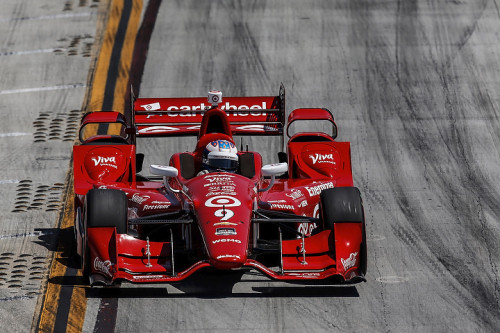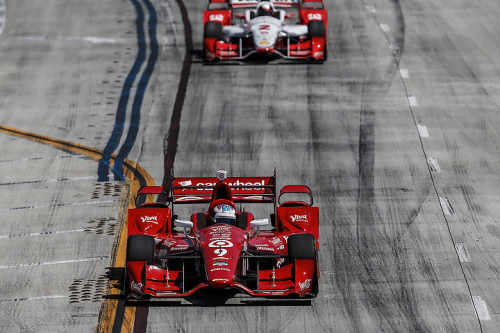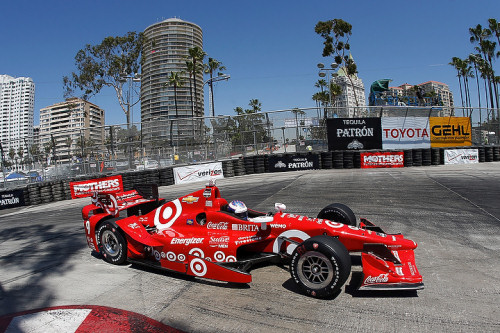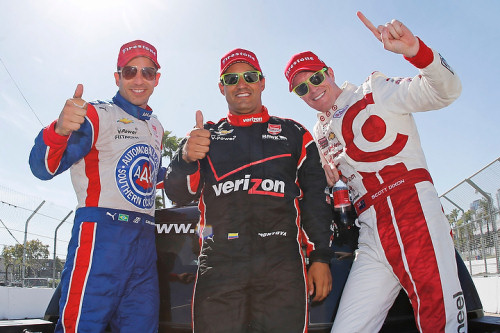The Way It Is/ Dialing in IndyCar's aero kitsby Gordon Kirby |
 As everyone knows, IndyCar is trying to revitalize itself this year with competing aero kits from Chevrolet and Honda. The process of designing, building, manufacturing and developing the aero kits has turned into a bigger and more costly job than many people imagined. At Long Beach last weekend I took some time to discuss the state of IndyCar's aero kit business with IndyCar's racing boss Derrick Walker and Honda Performance Development's COO and vice-president Steve Eriksen.
As everyone knows, IndyCar is trying to revitalize itself this year with competing aero kits from Chevrolet and Honda. The process of designing, building, manufacturing and developing the aero kits has turned into a bigger and more costly job than many people imagined. At Long Beach last weekend I took some time to discuss the state of IndyCar's aero kit business with IndyCar's racing boss Derrick Walker and Honda Performance Development's COO and vice-president Steve Eriksen.
"We've learned a lot," Walker began. "We put out aero kit rules and these manufacturers have been beavering away in their dark rooms. The first thing we saw when they came out was their competitive capability looked good but their structural capability was in question to the degree that we have a contact sport so guys do bump and grind. In the old system there was an ability to do that without too much penalty. "But when you open up various parts of the car so you've got multiple pieces to deal with rather than maybe two or three pieces, the tendency is to try and keep yourself on weight limit which means that you're going to design it to the minimum rather than the maximum it should be. But the manufacturers responded very well to it and we've gained a big chunk of that back already. "The problem is it takes time and production of the kits in general has been one area where the manufacturers have lagged behind. I think they underestimated how much time it required. But they're putting up a brave fight and they're probably spending a lot more money to get it out there by going to multiple manufacturers for those parts because they haven't go the time to do it in one place.  © LAT USA/Mike Levitt Many people are concerned about the additional aerodynamic loading on the cars from the new aero kits at big speedways like Indianapolis and Texas. "Of course, we've been looking at that," Walker said. "I think it's only at a couple of tracks where we have not so much the high loading but bumps with a high load. When you get a bump like at Iowa, at those speeds you can get spike loadings that can be very concerning. We were there last year so we've taken steps to slow-down the loadings you can get from that. We still have adjustment to scale back more downforce but that's something we do all the time. We have an adjustment in the aero kits and in last year's kit to take away or reduce downforce where necessary. "So we've got stiffer suspension than we had and we've got the final spec for those tracks where we have concerns with high loadings. We haven't finalized that specification. In fact, in the private drivers' meeting of their group we encouraged them to talk about what their feelings where and what the downforce figures should be acceptable for racing. "Although we're focused on the high loading we're also focused with equal importance on the pack racing aspect. The definition of pack racing is running a lap wide-open but when you can run multiple laps wide-open and when the whole field can multiple laps wide-open, you've got a worse case scenario. And downforce will do that for you. So how much downforce do we want? "The complex part of that is I suspect we've not seen the aero kits fully loaded. If they put on all the combination of bits that they have in their aero kit armory on, how much total downforce could they get? They're not going to came and share everything with us about their package but we're focused on that. That could be the missing link that we'll get to when we get closer to the time. "We've already taken away the strakes and the sidewalls which reduced a lot of the downforce. We also told the manufacturers don't build your kits around too many moving parts. That's one of the tools we have to tune the car with depending on what your requirement is. So we'll have to wait and see where we are."  © LAT USA/Mike Levitt "We applied very quickly some strengtheners, kind of like an additional layer of carbon in a couple of spots to further strengthen the parts," Eriksen reported. "Those made their debut at NOLA. I was very, very pleased to see how that turned out. We had a number of instances of car to car contact during that race. In fact, we've got photographs of endplates with giant tire marks on them where contact had happened, and we did not have a single instance of parts coming off the car. So that fix definitely worked well, and IndyCar was very, very pleased with what they saw from that race. "So we're going to give it another data point from Long Beach and then our plan is to essentially take that strength as a benchmark and then go back and make the same original shape but to that new strength level as a replacement part. So that way you retain the original homologated shape, the original aerodynamic intent, and you get the added strength. "I'm really quite pleased with the progress. Every session, the teams are learning more and more about the aero kit. If you look at last year's car, it made a lot of its performance with the under wing. Yes, you have wings, but the under wing made a lot of the performance. "IndyCar took away a ton of the performance of the under wing. That was part of the regulation change. So by necessity the cars now make more performance out of the wings than out of the under wing. So that changes inherently how a car has to be set up. So we're pleased they're coming to grips with that. "It's interesting watching the in-car video and the video that you see from the broadcast, just how much the Dallara main plane is being deformed. That's happening because we're putting a ton of force on it. We're making power out of that wing. The main plane, which last year didn't have to deal with much of that power, is now really getting a workout." Eriksen said the kits have added very little weight to the cars. "It's very, very minor," he said. "If you looked at the front wing endplate, the place that we reinforced was the base, the outer edge, the base of the outer edge of the front endplate. A very thin sheet of carbon molded perfectly to the shape that goes on the outside, one that goes on the inside, one goes on the bottom. It kind of sandwiches the base.  © LAT USA/Mike Levitt Honda will unveil its superspeedway kit for Indianapolis and other ovals in a few weeks. "You'll see some very interesting little elements as you look around the car," Eriksen said. "It's going to be a lot cleaner looking because you don't have all those drag-inducing, high downforce elements. But there are subtle little pieces around the car that have some very interesting aerodynamic effects. We're in the process of finalizing our plan for introducing that aero kit along with IndyCar probably just post Barber is what we're looking at." Eriksen is sure that only the surface of the aero kits potential has been scratched. "From a performance standpoint everybody's getting their heads around the fact that this is a different car and you have to set it up differently to extract the most out of the aero kit," he observed. "I don't think you've seen all of the performance that's possible from the kit. I'm pretty confident in that. "It's been a big exercise because nothing exists in isolation. So when we had an opportunity to design an aero kit, we also had the opportunity to change everything about the engine integration into the chassis. It was a chance for our engine guys and our chassis guys to really work together to extract the most out of this engine installation kit for this season. "We did a great job. We reduced weight. We improved power. The whole kit is better. They did a wonderful job. That can only be done when you have that kind of close working relationship between the chassis side and the engine side. It's been a great exercise engineering-wise."  © LAT USA/Mike Levitt "Everything that we've gotten as feedback from our teams said we made a huge step forward over the off-season. We can see it in the power curves. But they can feel it in the car. We've made such an increase that drivers are having trouble keeping that power to the ground. That's one of the things they're dealing with. This is so much power that I've got to rework the car to try to deal with the extra power." I asked Walker if he worried about getting into a CART Texas 2001 situation with so much loading that the drivers were blacking out. "For all of us who lived through that time I don't think you can put it out of your mind," he observed. "We would take steps if we thought we were going to get that far into it. I don't think from talking to our engineers that we're there yet, but the kits could put us there. "The one thing that we have that will slow us down from reaching that limit is we don't have the power we had back then. The combination of lots of downforce and lots of power, that cycle affected the drivers. So we've got less power but plenty of downforce and it's possible we could get into that area. We've got two critical tracks that we're looking at for that." Looking ahead, I asked Walker if he entertained any thoughts of experimenting with running cars without wings as many people have suggested. "That's actually a good question and a relevant question," Walker said. "It's one of those things that's coming into our discussion as we gradually wind our way into the discussion of what does IndyCar need for the future. Making a decision to make a change of any kind of that magnitude you've got to really get it right.  © LAT USA/Mike Levitt "You can slow cars down real easy but you can also make them pretty difficult to drive. The system we have right now has evolved over years. The tires have been designed around this downforce dependency. So you could go and read about how things might be without wings but it would be, 'Oh my God! This is undrivable.' You would have to get Firestone working on a tire combination that would work with less downforce and the drivers would have to get in the habit of changing their driving style so you could have a different answer. "So it's a complicated subject and that's why we need to look at it, and we will be shortly," Walker concluded. "This year is about trying to pull together our thoughts with various peoples' ideas and input and make a presentation to the fans, to the media, the owners, the manufacturers and say this is what we recommend. It wouldn't be a detailed drawing of how the car would be but it would be a concept of where we need to go. We've got a two year manufacturing development process before you run it. That to me is the right approach." |
|
Auto Racing ~ Gordon Kirby
Copyright ~ All Rights Reserved |
